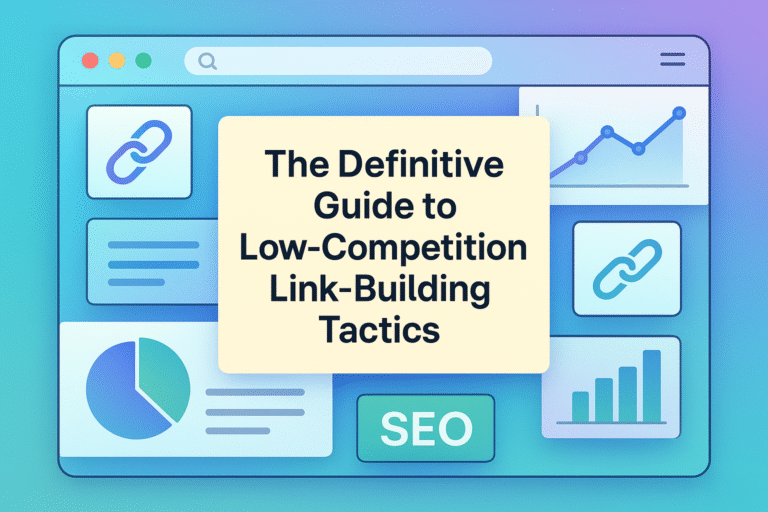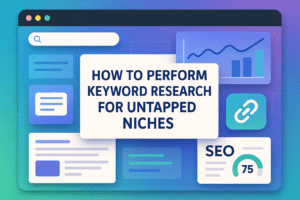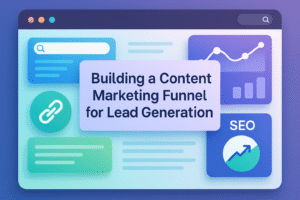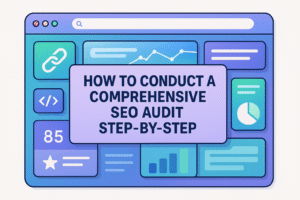In the dynamic realm of Search Engine Optimization (SEO), where each click is crucial and the competition is intense, devising innovative strategies for success demands precision and insight. With search engines dictating content visibility and high-authority backlinks being critical in ranking algorithms, mastering link-building is essential. Yet, many underestimate the potential of low-competition link-building, which can yield substantial results.
Low-competition link-building leverages less saturated niche opportunities to create high-quality backlinks, boosting a site’s authority. This strategic approach not only provides a competitive advantage but also explores untapped areas that can lead to impressive SEO outcomes. By employing white hat techniques and innovative, content-driven strategies, businesses can achieve organic growth ethically.
This guide delivers an in-depth exploration of low-competition link-building tactics, examining powerful methods such as leveraging unlinked brand mentions, employing the skyscraper technique, and harnessing the power of interactive content. We’ll demonstrate how these strategies can build a sustainable link profile, ensure measurable SEO impact, and attain long-term success without navigating steep competition.
Understanding Low-Competition Link-Building
Low-competition link-building tactics are essential for improving search engine visibility while adhering to Google’s guidelines. These strategies focus on quick wins with minimal effort and are designed to add value to users.
One effective method is leveraging linkless brand mentions or unlinked mentions from reputable sources. These unlinked mentions can be transformed into valuable links, providing a boost to your search engine rankings. Another technique involves analyzing and replicating competitors’ backlink profiles to gain high-quality, low-competition links.
Here’s a quick overview of actionable strategies:
| Tactic | Effort Required | Impact |
| Linkless/Unlinked Mentions | Low | Moderate to High |
| Competitor Backlink Analysis | Moderate | High |
| Internal Linking Improvements | Low | Moderate |
Targeting authoritative sites that drive actual traffic is crucial, as this significantly impacts the value of your obtained links. Ensure that every link adds quality and relevance to your backlink profile.
By crafting a well-rounded strategy considering ease of implementation, link impact, and expertise required, you can effectively improve your search engine rankings while maintaining compliance with Google’s terms of service.
The Importance of High-Quality Backlinks
High-quality backlinks are a cornerstone of effective link-building strategies. These links, originating from authoritative sites aligned with your niche, lend credibility and visibility to your content. Google’s algorithms prioritize both the quality and quantity of backlinks, significantly impacting search engine rankings.
Importance of High-Quality Backlinks:
– Reputational Value: Backlinks from trusted sites enhance your domain authority.
– Traffic Boost: Links from websites with consistent traffic increase content reach and engagement.
– Credibility Enhancement: Research-backed content attracts valuable links, establishing your site as a credible source.
For new websites, acquiring high-quality backlinks is critical to establishing authority and increasing exposure. Leveraging content marketing that includes blog posts or news stories validated by statistics can draw authoritative links, thereby improving search engine rankings.
Below is a table summarizing backlink quality indicators:
| Quality Indicator | Importance |
| Authoritative Source | High |
| Relevant Links | High |
| Stable Traffic Flow | High |
In conclusion, focusing on high-quality backlinks is not only about improving search rankings but also about building a credible and authoritative presence online.
White Hat Link-Building Techniques
White hat link-building strategies emphasize creating high-quality and relevant links that add genuine value to users while aligning with Google’s terms of service. These methods foster sustainable, long-term growth, ensuring that online environments are improved for both websites and users. Unlike black hat techniques, which can offer short-term gains with high risk, white hat techniques focus on durability and legitimacy. Incorporating methods like content creation, strategic partnerships, PR-level outreach, data studies, and email outreach, these strategies aim to attract high-quality backlinks. Notably, sharing proprietary data studies and developing industry-leading content can enhance website authority, attract more referral traffic, and secure a more reputable online presence.
Leveraging Unlinked Brand Mentions
Unlinked brand mentions represent valuable opportunities to amplify your brand’s online presence. These occur when a brand is mentioned on another site without a corresponding backlink. To leverage these opportunities effectively, begin by employing tools like Semrush’s Brand Monitoring app, Google Alerts, or Talkwalker to track instances of unlinked mentions. Once identified, the approach involves reaching out to the website owner in a polite manner, acknowledging the mention, and respectfully requesting a link. This not only enhances brand awareness but also augments the site’s visibility in search engines. Approaching this task with gratitude and offering additional value or insights can often lead to successfully converting these mentions into beneficial backlinks.
Implementing the Skyscraper Technique
The Skyscraper Technique is a savvy approach that involves creating content that surpasses the quality and depth of competitor offerings. By analyzing widely-linked competitor content and enhancing it, marketers can reach out to websites currently linking to those competitors with the proposition of switching to the improved content. This technique not only helps in acquiring new inbound links but also diverts traffic from competitors, positioning your content as a premier resource. Success in employing this method comes from offering extra incentives. Sharing the content on social media or other networks can be an enticing offer for website owners to make the switch. Consistency and engagement in follow-ups and discussions can further bolster the efficacy of this strategy.
Targeting Resource Pages
Resource page link building is a strategic approach that involves promoting a meticulously crafted, informative piece of content to pages dedicated to listing valuable resources. These pages are inherently designed to link out to high-quality content, making them prime targets for link-building efforts. To identify such pages, utilizing specific Google search strings like “Keyword” + inurl:links can be incredibly effective. The next step involves creating content that is not only valuable but also worthy of being featured on these resource pages. Alongside this, broken link building acts as a complementary tactic. By pinpointing broken links on resource pages and suggesting your content as a replacement, you can secure beneficial backlinks. This dual approach of pitching and replacing broken links fortifies your link-building strategy, leading to improved site authority and visibility.
Content-Led Link-Building Strategies
Content-led link-building is an approach focused on crafting high-quality and informative content that attracts natural links from reputable sites. This strategy blends content creation with PR-level outreach, aiming to not only enhance link profiles but also to bolster the brand’s authority within its industry. By producing engaging content such as data studies, infographics, and interactive posts, brands can draw organic links and build a strong backlink profile, which is crucial for improving search engine rankings. Additionally, this method aids in drawing referral traffic, which can be transformed into potential leads, making it particularly beneficial for B2B companies.
Creating Engaging Infographics
Infographics are a powerful tool within content-led link-building strategies, serving to visually summarize complex information in an engaging manner. These visually appealing graphics are ideal for recapping data and ideas alongside informative articles, enhancing reader comprehension and retention. When used in guest posts, infographics can secure topical, valuable links from bloggers eager to share striking visual content with their audiences. Incorporating well-designed infographics into a post—rather than relying on them as the sole focus—enhances their link-attracting capabilities while avoiding penalties from practices such as “infographic farms.” This strategy supports the generation of natural backlinks by presenting a substantial amount of information concisely and engagingly.
Conducting Data Studies for Link Attraction
Data studies are an effective method for attracting high-quality links, leveraging internal or external data to tell compelling stories about relevant brand-related topics. Large brands, in particular, can benefit from studies closely aligned with their products or services, thereby reinforcing their industry authority. A proactive promotion strategy is essential, where results are pitched to journalists and bloggers through email or press releases, drawing coverage and links. Endorsed by Google’s guidelines as effective white hat tactics, data studies also form a pivotal part of digital PR strategies. When original research yields valuable statistics, these become highly linkable assets as others cite the findings, significantly boosting backlink counts.
Utilizing Interactive Content
Interactive content, including dynamic infographics and engaging posts, plays a pivotal role in attracting links from reputable sites. By incorporating high-quality interactive elements, content naturally becomes more link-worthy and retains audience interest, making it a staple of content-led link-building strategies. Observing competitors can offer insights into what types of interactive content garner the most engagement and links. This tactic increases web page traffic and discoverability, contributing to improved search engine rankings. Crafting and promoting interactive content not only builds links but also enhances the overall user experience, positioning a brand as innovative and attentive to audience engagement.
Content-Less Link-Building Approaches
In the dynamic world of SEO, link building remains a critical factor for enhancing a webpage’s visibility and authority. However, traditional methods of acquiring backlinks often require content creation. Content-less link-building approaches offer an alternative path that allows websites to gain high-quality backlinks without producing new content. This strategy involves leveraging existing content or identifying unutilized opportunities to improve search engine rankings. Key to this is focusing on quality and relevance, ensuring that links come from reputable sites. By forming genuine relationships and adhering to white hat link-building tactics, marketers can maintain a natural backlink profile that aligns with search engine guidelines. Competitor analysis plays a crucial role here, revealing effective strategies and showcasing the type of content likely to earn links, even without fresh output.
Broken Link Reclamation
Broken link reclamation is an effective tactic that involves identifying broken links on reputable websites and suggesting your own site as a replacement. This approach leverages the website owner’s desire to eliminate non-functional outbound links, which could harm their web integrity. By proposing a functional link as a substitute, you not only assist them in maintaining their site’s quality but also gain a valuable link back to yours. Utilizing search strings, marketers can identify pages with numerous outbound links, while tools like Check My Links help pinpoint inactive links. The procedure usually involves reaching out to content managers via email, notifying them of the broken links, and suggesting appropriate replacements. This tactic can be highly effective as most website owners appreciate the effort to maintain quality content on their site. In addition, employing tools such as Pitchbox and HARO can significantly streamline the search for link replacement opportunities, making this an efficient alternative to creating new content.
Launching Digital PR Initiatives
Launching digital PR initiatives can effectively gain high-quality backlinks and enhance brand visibility without creating new content. Digital PR focuses on generating online coverage through creative and compelling narratives, often tied to interesting stories. These stories are crafted to attract media attention and result in valuable backlinks. An example of successful digital PR is Parkdean Resorts’ campaign, which involved creating a hedgehog-themed mini holiday park. This campaign linked to an environmental theme, gaining substantial media coverage.
Crafting press releases that connect with unique stories in the domain is crucial for digital PR efficacy. Reporters often look for noteworthy stories to cover, and if your narrative aligns with current trends, coverage is more likely. Responding to media requests can also present opportunities for features in high-quality publications, leading to authoritative backlinks.
To leverage digital PR effectively, it’s important to cultivate expertise in your field and use it to craft compelling narratives. Garnering such influence not only results in improved SEO outcomes but also enhances overall brand reputation. By blending creativity with strategic outreach, digital PR becomes a powerful tool in the content-less link-building tactics arsenal.
Assessing Backlink Value Factors
In the realm of SEO, understanding what makes a backlink valuable is crucial for enhancing search engine rankings. Backlink value is not merely about the number of links pointing to your site; it’s about the quality and authority of those links. Quality backlinks, especially from authoritative sites, hold significant weight in improving your site’s visibility on search engines. Through meticulous evaluation, one can determine which link-building tactics will most effectively boost their online presence. Two critical aspects stand out in assessing these backlink value factors: evaluating site authority and understanding link relevancy and placement within content.
Evaluating Site Authority
To assess backlink value effectively, determining the authority of the linking site is paramount. Site authority is a major factor because links from authoritative sites can significantly impact your SEO efforts. Tools like Semrush provide insights into a site’s authoritativeness by using an Authority Score, which evaluates link power, organic traffic, and the quality of a site’s backlink profile. Meanwhile, metrics like Moz’s Domain Authority or Majestic SEO’s Trust Flow offer additional perspectives on a site’s ranking capabilities and the quality of inbound links it can offer.
It is crucial to use a variety of metrics when assessing a site’s authority to avoid missing valuable link-building opportunities. Relying on a single metric could present an incomplete picture, potentially leading to missed opportunities for building quality backlinks. Moreover, while a resource page may boast a high Domain Authority, it might still provide little value if it has a low Page Authority or numerous outgoing links, which can dilute the SEO benefits. In your link-building strategy, aim for pages that reflect both high domain and page authority to maximize the potential SEO benefits.
Understanding Relevancy and Link Placement
The relevancy of a backlink and its placement within content are integral to its value in search engine optimization. By forming strategic partnerships with non-competing site owners in your niche, you can exchange relevant links that enhance the reader’s experience. Such collaborations should be based on mutual interests, with each party placing links in contextually appropriate content. Prioritizing content that others naturally want to link to is a hallmark of successful link building, and it avoids the pitfalls associated with linking to low-quality material.
Link placement is another crucial factor; links need to be embedded in content that highlights their relevancy, thus enhancing their perceived authority to search engines. By placing links within meaningful content, you can ensure they deliver more value to both users and search engines. Furthermore, adopting a diverse link-building strategy helps buffer against algorithm changes by creating a more robust and adaptable SEO framework. Such diversity ensures that your link building efforts remain effective, sustainable, and aligned with evolving search engine guidelines.
In summary, evaluating backlink value requires a nuanced approach that considers both the authority and relevancy of links. By focusing on these factors, you can develop an effective link-building strategy that enhances your site’s search engine performance.
Ensuring Trackable and Measurable Efforts
Ensuring that your link-building efforts are trackable and measurable is crucial for success. One effective strategy is utilizing the Backlink Gap Tool. This tool helps analyze competitors’ backlinks, providing valuable insights into effective link-building strategies and measuring progress.
To streamline your outreach, consider linking directly to a prospect’s resource page in your emails. This makes it easier to track interactions and reference shared content.
Responding to media requests also offers trackable opportunities to feature in high-quality publications, enhancing your measurable outreach success.
Conducting a thorough competitor backlink analysis is key. It provides insights into effective link-building strategies, allowing you to track their impact effectively.
Developing a structured link-building plan can significantly enhance your ability to measure the effectiveness of your tactics. By having a systematic approach, you can ensure that your efforts are well organized and yield tangible results.
Here’s a concise checklist to help maintain trackable efforts:
– Use the Backlink Gap Tool for competitor analysis.
– Directly link to prospect resource pages in emails.
– Respond to media requests for high-quality features.
– Regularly analyze competitor’s backlink profiles.
– Develop a structured link-building plan.
This approach will streamline your link-building process and maximize its impact on search engine rankings.
Long-Term SEO Gains Through Consistent Link-Building
Consistent link-building is crucial for achieving long-term SEO gains. By acquiring one-way hyperlinks, your site can enhance its search engine visibility and improve SEO rankings. Quality link-building strategies focus on attracting high-quality backlinks that convey your site’s authority and trustworthiness to search engines like Google.
A successful link-building plan aims to generate meaningful traffic by ensuring that your linked websites complement your content, thereby attracting relevant visitors. It’s important to diversify your link-building tactics to ensure sustainability. No single tactic should dominate more than 30-40% of your overall strategy, guarding against changes in search engine algorithms.
To create a well-rounded link-building strategy, consider the following approaches:
- Guest Posts: Share your knowledge on authoritative sites to gain exposure and backlinks.
- Link Reclamation: Identify and recover broken links or unlinked mentions of your brand.
- Internal Links: Enhance user experience and search rankings by strategically linking your content internally.
- Valuable Content: Focus on creating quality and valuable content to attract high-quality, natural backlinks.
By prioritizing these tactics and avoiding harmful practices, you can accumulate valuable and effective backlinks over time, ensuring sustainable improvements in search engine rankings.




